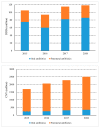Analysis of Antibiotic Use Patterns and Trends Based on Procurement Data of Healthcare Institutions in Shaanxi Province, Western China, 2015-2018
- PMID: 33081253
- PMCID: PMC7593904
- DOI: 10.3390/ijerph17207536
Analysis of Antibiotic Use Patterns and Trends Based on Procurement Data of Healthcare Institutions in Shaanxi Province, Western China, 2015-2018
Abstract
Overuse of antibiotics has caused a series of global problems, especially in the underdeveloped western regions where healthcare systems are fragile. We used antibiotic procurement data of all healthcare institutions to analyze the total amount, patterns and trends of antibiotic use in Shaanxi Province, western China between 2015 and 2018. Antibiotic utilization was quantified using the standard Anatomical Therapeutic Chemical (ATC)/Defined daily dose (DDD) methodology. The World Health Organization's "Access, Watch and Reserve" (AWaRe) classification and European Surveillance of Antimicrobial Consumption (ESAC) drug-specific quality indicators were also adopted to evaluate the appropriateness and quality of antibiotic utilization. Overall, antibiotic consumption decreased from 11.20 DID in 2015 to 10.13 DID (DDDs per 1000 inhabitants per day) in 2016, then increased to 12.99 DID in 2018. The top three antibiotic categories consumed in 2018 were J01C (penicillins) 33.58%, J01D (cephalosporins) 29.76%, and J01F (macrolides) 19.14%. Parenteral antibiotics accounted for 27.41% of the total consumption. The largest proportion of antibiotic use was observed in primary healthcare institutions in rural areas, which accounts for 51.67% of total use. Consumption of the Access group, the Watch group, the Reserve group of antibiotics was 40.31%, 42.28% and 0.11%, respectively. Concurrently, the consumption of J01D and the percentage of J01 (DD + DE) (third and fourth generation cephalosporins) were at a poor level according to the evaluation of ESAC quality indicators. The total antibiotic consumption in Shaanxi Province had been on an upward trend, and the patterns of antibiotic use were not justified enough to conclude that it was rational. This is partly because there was high preference for the third and fourth generation cephalosporins and for the Watch group antibiotics.
Keywords: antibiotic utilization; healthcare institutions; trends and patterns; west China.
Conflict of interest statement
The authors declare no conflict of interest.
Figures








Similar articles
-
Long-term trend of antibiotic use at public health care institutions in northwest China, 2012-20 -- a case study of Gansu Province.BMC Public Health. 2023 Jan 5;23(1):27. doi: 10.1186/s12889-022-14944-6. BMC Public Health. 2023. PMID: 36604660 Free PMC article.
-
Effects of restrictive-prescribing stewardship on antibiotic consumption in primary care in China: an interrupted time series analysis, 2012-2017.Antimicrob Resist Infect Control. 2020 Sep 25;9(1):159. doi: 10.1186/s13756-020-00821-7. Antimicrob Resist Infect Control. 2020. PMID: 32977855 Free PMC article.
-
Determining the impact of the COVID-19 pandemic on the consumption of antibiotics in Shaanxi province, China: an interrupted time-series analysis.Front Public Health. 2025 Feb 19;13:1475207. doi: 10.3389/fpubh.2025.1475207. eCollection 2025. Front Public Health. 2025. PMID: 40046123 Free PMC article.
-
European Surveillance of Antimicrobial Consumption (ESAC): quality indicators for outpatient antibiotic use in Europe.Qual Saf Health Care. 2007 Dec;16(6):440-5. doi: 10.1136/qshc.2006.021121. Qual Saf Health Care. 2007. PMID: 18055888 Free PMC article.
-
Quantitative antibiotic use in hospitals: comparison of measurements, literature review, and recommendations for a standard of reporting.Infection. 2008 Dec;36(6):549-59. doi: 10.1007/s15010-008-7462-z. Epub 2008 Nov 13. Infection. 2008. PMID: 19011740 Review.
Cited by
-
Analysis of antibiotic use patterns in Danish hospitals 2015-2021 using an adapted version of the who aware classification.BMJ Open Qual. 2022 Nov;11(4):e002098. doi: 10.1136/bmjoq-2022-002098. BMJ Open Qual. 2022. PMID: 36418070 Free PMC article.
-
Spatial and Temporal Distribution Characteristics and Potential Risks of Sulfonamides in the Shaanxi Section of the Weihe River.Int J Environ Res Public Health. 2022 Jul 15;19(14):8607. doi: 10.3390/ijerph19148607. Int J Environ Res Public Health. 2022. PMID: 35886459 Free PMC article.
-
Assessment of antibiotic consumption patterns in hospital and primary healthcare using WHO Access, Watch and Reserve classification (AWaRe) in Sichuan Western China: 2020.Arch Public Health. 2024 Oct 14;82(1):182. doi: 10.1186/s13690-024-01391-5. Arch Public Health. 2024. PMID: 39402638 Free PMC article.
-
Impact of Antibiotic Consumption on Antimicrobial Resistance to Invasive Hospital Pathogens.Antibiotics (Basel). 2023 Jan 28;12(2):259. doi: 10.3390/antibiotics12020259. Antibiotics (Basel). 2023. PMID: 36830170 Free PMC article.
-
Antibiotic Use in China's Public Healthcare Institutions During the COVID-19 Pandemic: An Analysis of Nationwide Procurement Data, 2018-2020.Front Pharmacol. 2022 Feb 14;13:813213. doi: 10.3389/fphar.2022.813213. eCollection 2022. Front Pharmacol. 2022. PMID: 35237164 Free PMC article.
References
-
- O’Neill J. Antimicrobial Resistance: Tackling a Crisis for the Health and Wealth of Nations. [(accessed on 14 April 2020)];2014 Available online: https://amr-review.org/
Publication types
MeSH terms
Substances
LinkOut - more resources
Full Text Sources
Medical
Research Materials

